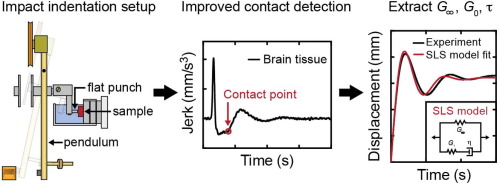Acta Biomaterialia ( IF 9.7 ) Pub Date : 2018-03-01 , DOI: 10.1016/j.actbio.2018.02.017 Aleksandar S. Mijailovic , Bo Qing , Daniel Fortunato , Krystyn J. Van Vliet

|
Precise and accurate measurement of viscoelastic mechanical properties becomes increasingly challenging as sample stiffness decreases to elastic moduli less than 1 kPa, largely due to difficulties detecting initial contact with the compliant sample surface. This limitation is particularly relevant to characterization of biological soft tissues and compliant gels. Here, we employ impact indentation which, in contrast to shear rheology and conventional indentation, does not require contact detection a priori, and present a novel method to extract viscoelastic moduli and relaxation time constants directly from the impact response. We first validate our approach by using both impact indentation and shear rheology to characterize polydimethylsiloxane (PDMS) elastomers of stiffness ranging from 100s of Pa to nearly 10 kPa. Assuming a linear viscoelastic constitutive model for the material, we find that the moduli and relaxation times obtained from fitting the impact response agree well with those obtained from fitting the rheological response. Next, we demonstrate our validated method on hydrated, biological soft tissues obtained from porcine brain, murine liver, and murine heart, and report the equilibrium shear moduli, instantaneous shear moduli, and relaxation time constants for each tissue. Together, our findings provide a new and straightforward approach capable of probing local mechanical properties of highly compliant viscoelastic materials with millimeter scale spatial resolution, mitigating complications involving contact detection or sample geometric constraints.
Statement of significance
Characterization and optimization of mechanical properties can be essential for their proper function of biomaterials in diverse applications. However, precise and accurate measurement of viscoelastic mechanical properties becomes increasingly difficult with increased compliance (particularly for elastic moduli < 1 kPa), largely due to challenges detecting initial contact with the compliant sample surface and measuring response at short timescale or high frequency. By contrast, impact indentation has highly accurate contact detection and can be used to measure short timescale instantaneous response. Here we demonstrate an experimental and analytical method that confers significant advantages over existing approaches to extract spatially resolved viscoelastic moduli and characteristic time constants of biological tissues (e.g., brain and heart) and engineered biomaterials.
中文翻译:

使用冲击压痕表征高顺应性聚合物和生物组织的粘弹性力学性能
随着样品刚度降低到小于1 kPa的弹性模量,粘弹性机械性能的精确和精确测量变得越来越具有挑战性,这主要是由于难以检测到与顺应样品表面的初始接触所致。此限制与生物软组织和顺应性凝胶的表征特别相关。在这里,我们采用冲击压痕,与剪切流变学和常规压痕相比,不需要先验接触检测,并提出了一种直接从冲击响应中提取粘弹性模量和松弛时间常数的新方法。我们首先通过使用冲击压痕和剪切流变学来表征硬度从100s Pa到近10 kPa的聚二甲基硅氧烷(PDMS)弹性体,从而验证了我们的方法。假设材料的线性粘弹性本构模型,我们发现通过拟合冲击响应获得的模量和弛豫时间与通过拟合流变响应获得的模量和弛豫时间非常吻合。接下来,我们展示了从猪脑,鼠肝和鼠心获得的水合生物软组织的验证方法,并报告了每种组织的平衡剪切模量,瞬时剪切模量和弛豫时间常数。一起,
重要声明
机械性能的表征和优化对其在各种应用中生物材料的正常功能至关重要。然而,随着顺应性的提高(尤其是对于弹性模量<1 kPa),精确和准确地测量粘弹性力学性能变得越来越困难,这主要是由于挑战在于检测与顺应性样品表面的初始接触以及在短时间范围内或在高频下测量响应所带来的挑战。相比之下,冲击压痕具有高度精确的接触检测,可用于测量短时标的瞬时响应。在这里,我们演示了一种实验和分析方法,与现有方法相比,该方法具有明显的优势,可以提取空间分辨的粘弹性模量和生物组织的特征时间常数(例如大脑和心脏)和工程生物材料。


























 京公网安备 11010802027423号
京公网安备 11010802027423号